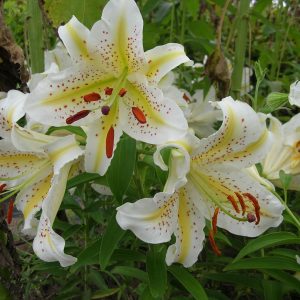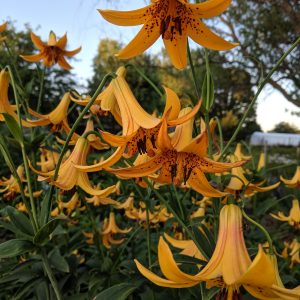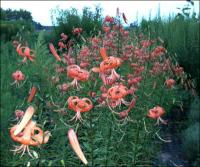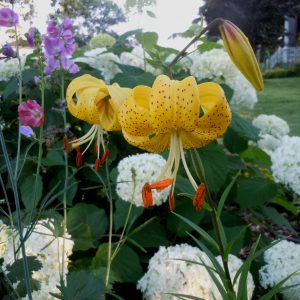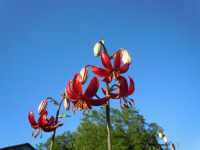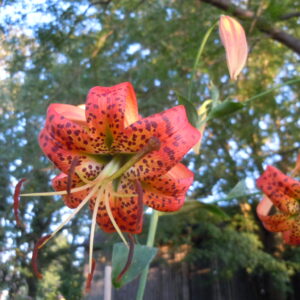Perennials & Biennials
Showing 281–288 of 485 results
-
Ligularia stenocephala Leopard plant Z 4-8
Daisy-shaped buttercup to golden yellow flowers cover narrow, 4-5 ‘tall spikes from late summer to early fall. Its foliage is as arresting as the flowers. Big, rounded-triangular shaped leaves with sharply scissored edges surround the bottom with smaller ones cover the stems until the leaves meet the bottoms of the flower spike.
Daisy-shaped buttercup to golden yellow flowers cover narrow, 4-5 ‘tall spikes from late summer to early fall. Its foliage is as arresting as the flowers. Big, rounded-triangular shaped leaves with sharply scissored edges surround the bottom with smaller ones cover the stems until the leaves meet the bottoms of the flower spike.
Size: 5’ x 5’
Care: part shade in moist soil
Native: China, Taiwan, and Japan
Wildlife Value: a favorite nectar and pollen source for bees and butterflies. Rabbit resistantCollected and first named by Russian botanist Carl Johann Maximowicz (1827 – 1891). St. Peterburg Botanic Garden sent him to South America where he searched for plants around Rio, then crossing Cape Horn he collected in Hawaii. After his ship was commandeered off the coast of China, he crossed China from west to east through China and Siberia recording his specimens that grew along the Amur River. He returned traveling west to east then crossed the East China Sea of the Pacific Ocean to Japan where he collected for four years.
-
Lilium auratum Gold-band lily, Yamayuri in Japan Z 5-8
Very fragrant, recurved white trumpets with gold bands radiating from the center down the middle of each petal, decorated with red spots. Blooms in late summer.
Very fragrant, recurved white trumpets with gold bands radiating from the center down the middle of each petal, decorated with red spots. Blooms in late summer.
Size: 3-4’ x 12”
Care: Plant 3-4 times deeper than the bulb’s height, i.e. if bulb is 2’ tall plant the bottom of the bulb 4” deep. Sun to part shade in well-drained soil, slightly acidic. Mulch.
Native: Japan in forest edges in mountains north of south-central Honshu Island.
Awards: Royal Horticultural Society Award of Garden MeritLilium was named for the Greek word for smooth, polished referring to its leaves. The Chinese cultivated this lily since 1688. Japanese cultivated this bulb as a vegetable: “I have eaten them pretty often, and rather relished them, as they are, when cooked, sweet, mucilaginous, and without any decided taste to make them objectionable to a newcomer.” American Gardener, May 1882. English nurseryman John Veitch introduced this lily to Europe in 1861. Considered “queen of the lilies” in late Victorian gardens. The Wisconsin Horticultural Society described it as the “most beautiful of all Japan lilies…” (1896).
-
Lilium canadense, Z 2-6
Showy, drooping bell-shaped flowers from lemon to dark orange in color with conspicuous red spots on the inside
OUT OF STOCK
Showy, drooping flowers from lemon to dark orange in color with conspicuous red spots on the inside.
Size: 2-4’ x 6”
Care: part shade in moist to moist well-drained, slightly acidic soil
Native: Upper Great Lakes & southern Canada
Wildlife Value: attracts butterfliesIntroduced to gardens from its native North America by Jacques Cartier, 1535. Also collected by Swedish botanist Pehr Kalm (1716-1779) who collected in Northeastern US and SE Canada and sent it to Linnaeus. Grown at America’s 1st botanic garden, Elgin Botanic Garden 1811. Listed in the 1873 catalog of Leichtlin’schen Gartens in Baden-Baden.
-
Lilium lancifolium Tiger lily, in Japan called “oniyuri” Z 2-7
Late summer, orange, recurved blossoms with black spots
Late summer, orange, recurved blossoms with black spots
Can not ship to: Delaware and Maryland.
Size: 3-4' x 12"
Care: Sun to part shade in any soil
Native: AsiaLilium was named for the Greek word for smooth, polished referring to its leaves. The Tiger lily was in Chinese literature as long ago as the 10th century. The Chinese grew it in rows as a vegetable and wrote it brought the pained dragon to life. First described for the West by Englebert Kaempfer, physician to Dutch East India Co. on Deschema Island in the 1690’s. William Kerr sent the Tiger lily from Canton China to Kew in England in 1804. First Asian lily imported to America. A Tiger lily grew in Wonderland’s looking glass garden where it told Alice “We can talk…when there is anybody worth talking to.”
-
Lilium leichtlinii Leichtlin’s Lily, Citronella Lily Z 5-9
Up-curved petals on down-facing, yellow flowers freckled with dark spots grace a tall stem with multiple horizontal side shoots, each ending with a flower in June-July.
Up-curved petals on down-facing, yellow flowers freckled with dark spots grace a tall stem with multiple horizontal side shoots, each ending with a flower in June-July.
Size: 3-4’ x 10”
Care: sun to part shade in humus-rich, moist well-drained soil
Native: central Honshu Japan among tall grasses in moist meadowsIntroduced from Japan by the London nursery of Veitch and Sons and described first in Bot. Mag. 93: t. 5673 1867 wherein it was named for German horticulturist Maximilian Leichtlin (1831-1910) He worked at several gardens in Europe then traveled to South America and then founded a botanic garden in Baden-Baden, Germany specializing in bulbous plants. Listed in the 1873 catalog of Leichtlin’schen Gartens in Baden-Baden.
-
Lilium martagon Martagon lily Z 3-8
Usually pink to carmine, smallish downfacing, reflexed petals, with one stem baring up to 50 individual flowers on mature plant.
OUT OF STOCK
Usually pink to carmine, smallish downfacing, reflexed petals, with one stem baring up to 50 individual flowers on mature plant.
Size: 3-6’ x 8-12”
Care: part shade to sun (shorter in sun) in well-drained, lime soil. Resents being moved & often will not emerge in 1st year.
Native: Eastern France to Korea.
Awards: Royal Horticultural Society Award of Merit; Elisabeth C. Miller Botanic Garden Great Plant Pick.The name Martagon means cap in Turkish from the style of turban adopted by Turkish ruler, Sultan Mohammed, which was known as a martagon and had a similarly pendulous shape. Described by English herbalist Gerard (1545-1612) in 1596.
-
Lilium michiganense Michigan lily Z 4-8
The top of each erect stem curves over like a hook. A single red or orange flower dangles from the stem’s tip. Spotted petals (botanically called tepals) curve up with their tips nearly reaching the top of the flower. Stamens hang down from the center then flare out inviting bees and butterflies to its pollen. They flower for nearly a month in mid-summer.
OUT OF STOCK
The top of each erect stem curves over like a hook. A single red or orange flower dangles from the stem’s tip. Spotted petals (botanically called tepals) curve up with their tips nearly reaching the top of the flower. Stamens hang down from the center then flare out inviting bees and butterflies to its pollen. They flower for nearly a month in mid-summer.
Size: 2-5’ x 8-10”
Care: sun to part-shade in moist to moist well-drained, neutral to acidic soil.
Native: New Hampshire west to Wisconsin, south to Arkansas, east to Alabama and Florida
Wildlife Value: attracts hummingbirds, bees, and butterfliesThis had several prior names, as varieties or subspecies of Lilium canadense or Lilium speciosum. In 1915 botanist Oliver Atkins Farwell (1867-1944) renamed it in “Notes of Michigan Liliaceae,” Bulletin of Torrey Botanical Club 42, p. 353, based on one he collected in 1910 in Wiard’s Crossing, Michigan.
-
Lilium superbum Meadow lily Z 4-8
Brilliant orange with purple spots, Turks’-cap type, reflexed petals (tepals), blooming in late summer to early fall.
Brilliant orange with purple spots, turks-cap lily with dramatic, swept-back petals blooming late summer to early fall. Slow to mature but when it does it bears up to 40 flowers on one plant.
Size: 10’ x 12”
Care: Sun in moist to moist-well-drained, acidic soil
Native: from VT to Fl & west to Mississippi River, Wisconsin nativeLilium was named for the Greek word for smooth, polished referring to its leaves. This collected before 1665. In his 1665 book, Flora, seu de Florum Cultura John Rea, nurseryman and author, called it the “Virginia Martagon.” Sold in America’s 1st plant catalog, Bartram’s Broadside, 1783. L.H. Bailey (1913): “The most magnificent and showy of native North American species, well worthy of extensive cultivation.”


